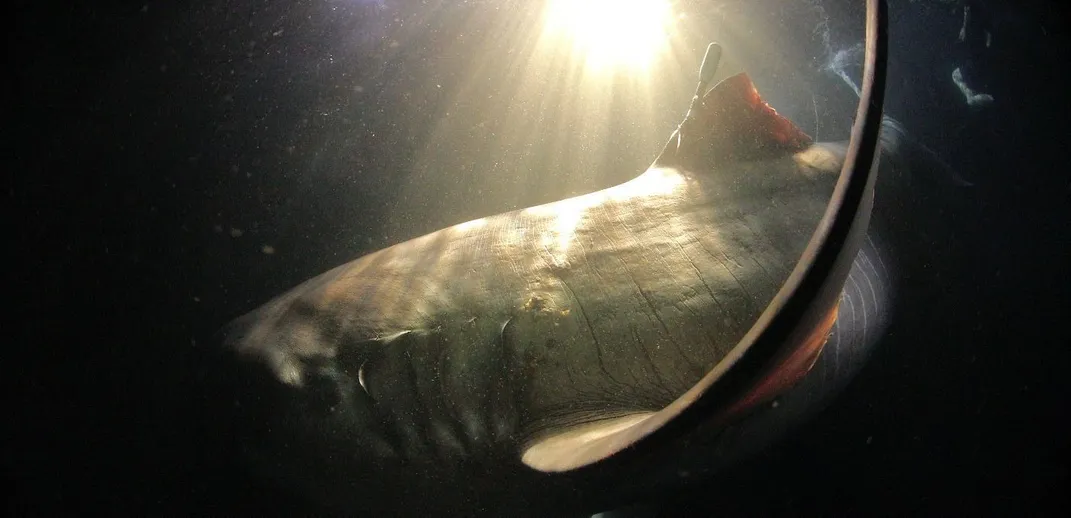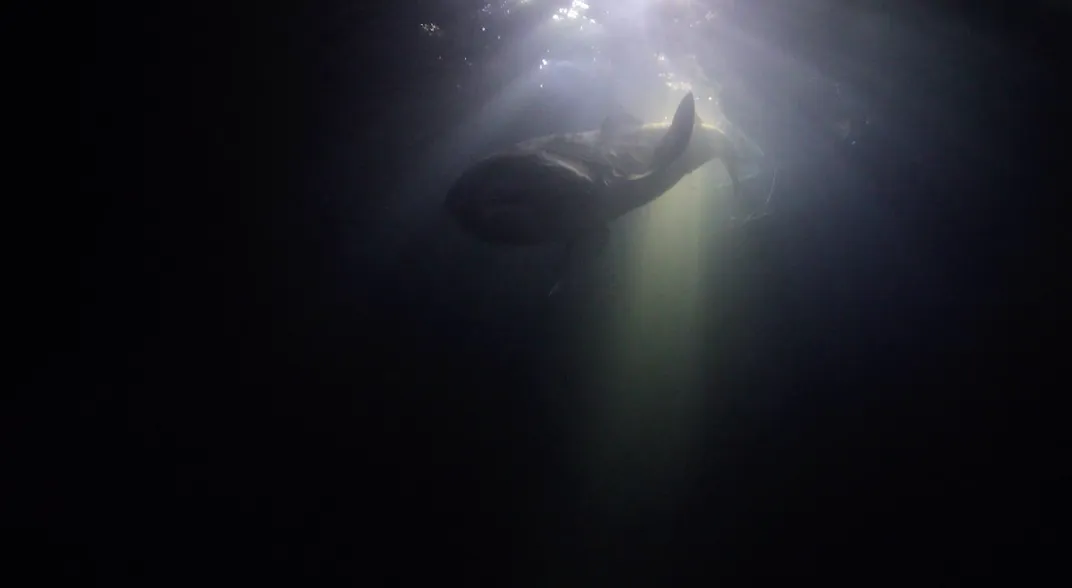NATIONAL MUSEUM OF NATURAL HISTORY
Rare Megamouth Shark Arrives at the Smithsonian
Studying and eventually preserving the megamouth will help researchers learn more about the puzzling species, allowing them to examine the sharks’ impact on the ocean ecosystem and food chain.
/https://tf-cmsv2-smithsonianmag-media.s3.amazonaws.com/blogging/featured/A_view_from_the_front_of_a_shark_underwater..jpg)
In 2018, a large shark with a truly gigantic head was taken by fishers off the coast of Taiwan, causing waves among ichthyologists and marine biologists.
The elusive megamouth shark, Megachasma pelagios, is famous for a reason best described by its common name: it has an incredibly large mouth and lives in the sea. Megamouths were first scientifically observed in the 1970s. Since then, there have been more than 60 but less than 240 confirmed captures of individual sharks. This uncertainty shows how little scientists know about the shark. And no one knows how many live in the wild.
When scientists heard about the megamouth specimen, they knew it could hold key information about the mysterious species. So they contacted the Smithsonian’s National Museum of Natural History to arrange transport and preservation for the specimen.
“When you have an opportunity like this, it’s a chance to gather baseline information on a species that is just so hard to capture in any other way,” said Diane Pitassy, a museum specialist and Assistant to the Chair for Collections for the Division of Fishes. She facilitated the specimen’s acquisition.
Shark specimens, like most fish specimens in natural history museums, are usually fixed in formaldehyde and stored in ethyl alcohol — a common practice that keeps specimens intact for decades if not centuries. But the museum’s newly acquired megamouth has not been preserved yet. It rests in a frozen block at the Museum’s Support Center, where researchers from the museum’s Division of Fishes and elsewhere plan to study its anatomy and DNA for clues about the evolution and biology of the species.
A big mouth with a lot of secrets

Megamouths are one of three filter-feeding species of sharks. Because they are so enigmatic, little is known about their habitats, migration patterns and life histories.
“When it comes to sharks, they’re probably one of the most unique and weird-looking species. Their mouth just keeps opening and their upper jaw closes like a convertible hood,” said Paul Clerkin, a graduate researcher at the Virginia Institute of Marine Science who collected the Smithsonian’s new specimen in Taiwan.
Researchers will race to collect valuable genetic data before the rapidly decaying specimen is preserved to prevent rot. Typically, freezing a megamouth is impossible because it is too large and the process too costly. But with support from a bigger research institution, freezing becomes a realistic option.
“We have the means, the space and the facility to get a big tank for a big specimen. We are one of the few museums who could embrace this,” said Dr. Lynne Parenti, the Curator of Indo-Pacific Freshwater and Coastal Fishes at the museum who worked with Pitassy on the acquisition.
Once research resumes at the Smithsonian’s Museum Support Center, Clerkin will collaborate with others in the field to study the shark’s brain, stomach parasites, diet and age.
“You almost never hear about a megamouth being transported to a museum, especially in the United States. Almost everything that we know about them, we’ve had to learn from dead specimens that are usually preserved,” said Clerkin. “The plan is to take all the data and samples that we can and see how it fits together to give us a better idea of megamouth’s life history.”
“Shark Tank” museum-style
Once researchers take their samples, staff will preserve the megamouth in its tank at the Museum Support Center, first with formaldehyde to stop tissue decomposition and then ethyl alcohol for long term storage. As time passes, the shark will remain as proof that there was at least one megamouth —and likely more — who swam in the ocean in 2018.
“Even if we never ever collect one again, we’ll still know that megamouth sharks existed on Earth at this time. We’re preserving this for everyone for what it shows about basic biodiversity. It could also answer questions that haven’t been asked yet,” said Parenti. “100 years from now, someone might say we want to look at the megamouth and it will be available.”

After the megamouth is preserved, it will join over six million other specimens in the Division of Fishes’ collections — a comprehensive ichthyological biorepository dedicated to preserving snapshots of species in time for the next generation of scientists with new technologies.
Studying and eventually preserving the megamouth will help researchers learn more about the puzzling species, allowing them to examine the sharks’ impact on the ocean ecosystem and food chain.
“Understanding the life history of sharks is important, especially because we don’t know their full role in marine ecosystems or how sensitive they are to human-made pressures. They’re a big influence on the world,” said Clerkin.
Related Stories:
Scientists Brave One of the Darkest Places on Earth for Rare Predatory Worm
Notorious Asian Giant Hornet Finds Home in Smithsonian
Digitization Allows Public Access to Smithsonian’s Hidden Collections
Saving This Rare Whale Skeleton was a Dirty Job

